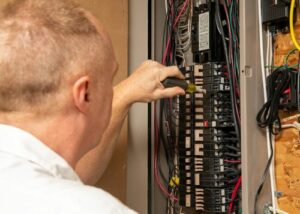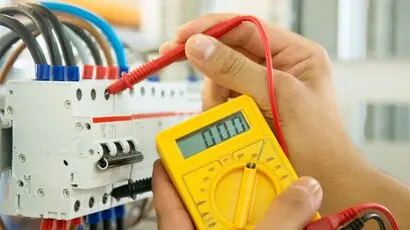Usual Electric Issues Every Property Owner Ought To Learn about
Home owners typically experience numerous electrical problems that can influence safety and security and performance. Issues like flickering lights and tripped circuit breakers are a lot more common than numerous understand. These circumstances can show deeper electrical issues that warrant focus. Comprehending the dangers and signs related to out-of-date wiring and dead electrical outlets is crucial. What steps can be required to avoid these troubles? Checking out these common electrical concerns might disclose essential understandings for maintaining a secure home environment.

Flickering Lights: Causes and Solutions
Why do some homeowners experience flickering lights? Flickering lights can be a common annoyance, frequently indicating underlying electrical problems. One main reason is faulty or loosened links within lighting fixtures or circuitry, which can bring about intermittent power supply. In addition, using high-wattage devices on the exact same circuit might trigger voltage variations, leading to dimming or flickering. One more possible problem is an overloaded circuit, where as well lots of tools draw power all at once, straining the electrical system. Outdated or degraded electrical wiring can contribute to irregular electric circulation. Sometimes, flickering lights might signify a problem with the home's electric panel or service line. House owners ought to attend to flickering lights without delay to stay clear of potential hazards. Solutions may consist of tightening links, rearranging device tons, or seeking advice from a certified electrical contractor for a complete evaluation. Identifying the origin reason can aid assure a safe and steady electrical system in the home.
Tripped Circuit Breakers: What You Need to Know
Have home owners ever before questioned what triggers their circuit breakers to trip all of a sudden? This typical concern commonly arises from an overload of electric circuits, where as well many tools draw power at the same time. In such situations, the circuit breaker acts as a safety system, interrupting the circulation of power to avoid getting too hot and possible hazards. Another constant reason is a short circuit, which happens when an online cable get in touches with a neutral cord, creating a rise of electrical energy that journeys the breaker. Ground faults can also result in stumbled breakers; these occur when a live cable touches the ground or a based surface area, positioning major security risks. Homeowners must frequently analyze their use of high-wattage home appliances to prevent straining circuits. In addition, understanding the feature of breaker can aid them react appropriately during a trip, ensuring their home remains secure and well-kept.
Outdated Electrical Wiring: Indicators and Risks
Outdated electrical wiring can pose significant dangers to home owners, commonly going unnoticed up until problems emerge. Homes built prior to the 1980s might still have aluminum circuitry or knob-and-tube systems, which are no longer considered secure. Indicators of outdated wiring include flickering lights, frequently tripped circuit breakers, or burning smells near outlets. These signs might suggest that the electric system is loaded down or deteriorating.Additionally, homeowners could observe swelter marks around outlets or switches, which can indicate overheating. The threat of electric fires considerably increases with out-of-date circuitry, as these systems were not designed to handle modern-day electrical tons. Property owners are motivated to have their circuitry evaluated routinely, particularly when refurbishing or adding new devices. By acknowledging these signs early, they can stay clear of hazardous situations and maintain a safer living atmosphere. Upgrading to existing electric criteria is a positive action in keeping home safety and effectiveness.
Frequently Blown Fuses: Troubleshooting Tips
Regular blown merges can suggest underlying electrical concerns that may come from out-of-date electrical wiring or overloaded circuits. Home owners experiencing this issue must initially determine the appliances attached to the affected circuit. It is recommended to stay clear of using several high-wattage gadgets at the same time, as this can bring about circuit overload. If the problem persists, inspecting the circuit box for indications of wear or damages is important; a defective fuse box may need replacement.Additionally, looking for loose links within the circuit can aid prevent future incidents. Home owners need to likewise confirm that the fuses being utilized are of the appropriate amperage, as using an inaccurate fuse can exacerbate the issue. If these repairing suggestions do not you could try these out settle the problem, getting in touch with an accredited electrician is advised to examine the electric system better. Dealing with these worries quickly can help mitigate threats and assure the safety of the home's electric framework.
Dead Electrical Outlets: Common Causes and Repairs
When a property owner comes across a dead electrical outlet, it can typically be a resource of disappointment and confusion. Numerous usual reasons might cause this problem. One frequent wrongdoer is a stumbled breaker, which can be easily reset. If any breakers are in the off setting, homeowners need to examine their electrical panel to inspect. Another possibility is a damaged outlet itself, which may need substitute. Furthermore, loose wiring links within the outlet can disrupt power flow, making assessment essential.Sometimes, the problem might stem from an overloaded circuit, especially when numerous tools are linked. In such situations, redistributing the electric tons can fix the problem. Home owners ought to also consider the age of their electrical wiring; older systems might require updates to satisfy modern-day electric demands. If these steps do not correct the situation, consulting a certified electrical expert is advisable to assure safety and security and appropriate diagnosis.
Electric Shocks: When to Be Concerned
Just how can property owners determine whether an electrical shock warrants worry? House owners should first assess the severity and context of the shock. A moderate fixed shock, typically really felt when touching steel things, is generally harmless and common. However, if the shock happens while connecting with a plugged-in device or electrical outlet, it might show a more serious issue.The place and regularity of the shocks are important. Repeated shocks from the same resource, specifically in damp locations like shower rooms or kitchens, could indicate malfunctioning electrical wiring or insufficient grounding. Property owners should likewise take into consideration the sensation of the shock; a jolt that causes discomfort or contraction is extra worrying than a mere tingle.If there's any kind of uncertainty, it is recommended to seek advice from a certified electrical expert. Disregarding prospective electric threats can result in serious safety and security dangers, consisting of fire or extreme injury.
Overloaded Circuits: Prevention and Precaution
Overloaded circuits present considerable risks in household settings, usually bring about electrical fires or equipment damage (Level 2 Electrician). House owners need to identify the indicators of an overloaded circuit, such as regularly tripped breakers or dimming lights. Implementing preventative security techniques can help minimize these why not check here threats and assure a safer living environment
Identifying Overloaded Circuits
What signs indicate that a circuit may be strained? Home owners must be alert for a number of essential signs. Often tripped circuit breakers or blown integrates recommend extreme lots on the circuit. Lowering or flickering lights, particularly when various other appliances remain in usage, can represent a poor power supply. Additionally, outlets or buttons that feel warm to the touch might indicate getting too hot, a prospective fire threat. Uncommon humming noises from outlets also necessitate attention, as they can symbolize electrical concerns. Finally, if devices operate inefficiently or fall short to start, it might be an indication of an overloaded circuit. Recognizing these indicators early can aid protect against significant electrical issues and advertise a much Recommended Site safer home environment.
Preventive Safety Practices
To maintain a efficient and safe electrical system, homeowners must implement precautionary safety and security methods that address possible circuit overloads. One reliable step is to stay clear of linking as well many gadgets to a solitary electrical outlet, as this can go beyond the circuit's capacity. Utilizing power strips with built-in breaker can assist distribute power safely. Property owners should additionally on a regular basis evaluate cables and appliances for damages and change any damaged tools promptly. It is vital to ensure that circuit breakers are working appropriately and to be familiar with the overall electrical power being used in each circuit. Additionally, seeking advice from an accredited electrical contractor for routine evaluations can identify prospective issues before they escalate, guaranteeing a safer living environment and extending the life-span of electric systems.
Regularly Asked Questions
Exactly how Commonly Should I Have My Electric System Inspected?
Regular assessments of electric systems are advised every 3 to five years. Property owners should think about more regular checks if they experience issues, carry out restorations, or live in older residential properties to guarantee safety and compliance.
Can I Fix Electric Problems Myself or Hire a Specialist?

What Are the Signs of an Electrical Fire Risk?
Signs of an electrical fire risk include frequently stumbled breaker, flickering lights, shedding smells, blemished electrical outlets, or warm, humming wires. Homeowners ought to stay watchful and look for expert aid if any one of these indicators are existing.
Just how Do I Know if My Home Requirements an Electrical Upgrade?
To determine if a home needs an electrical upgrade, signs consist of frequent circuit breaker journeys, obsolete wiring, inadequate electrical outlets, flickering lights, and the visibility of older electrical panels, suggesting possible safety dangers and inadequacy.
Exist Specific Security Tips for Do It Yourself Electrical Job?
When considering DIY electric job, one ought to always shut off power, utilize insulated devices, confirm circuit functionality, adhere to local codes, and get in touch with professionals for complicated tasks to guarantee safety and protect against accidents. One more potential concern is an overloaded circuit, where too numerous tools draw power concurrently, stressing the electric system. The risk of electrical fires markedly increases with obsolete circuitry, as these systems were not developed to take care of contemporary electrical loads. Regular blown merges can indicate underlying electric issues that might stem from out-of-date electrical wiring or overloaded circuits. To preserve a effective and safe electric system, house owners must execute precautionary safety practices that address prospective circuit overloads. ASP Level 2 Electrician. Indications of an electrical fire risk consist of often stumbled circuit breakers, flickering lights, melting smells, tarnished electrical outlets, or cozy, buzzing wires